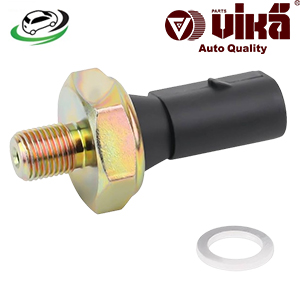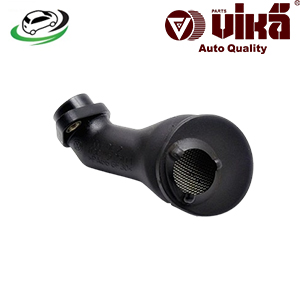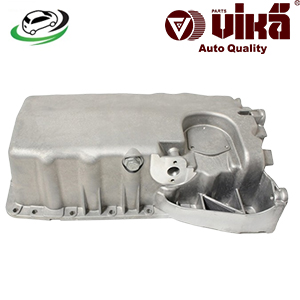-9%
Get Engine Oil Pan VW Beetle/ Golf/ Jetta / AUDI TT Quattro/ TT 038103601MA
The engine oil pan, often simply called the oil pan, is a crucial component of an internal combustion engine’s lubrication system. It’s a metal container located at the bottom of the engine block that serves as a reservoir for engine oil. Its design, material, and function are integral to ensuring the engine runs smoothly, efficiently, and with minimal wear.
1. Design and Structure
The oil pan is typically made from materials like stamped steel or aluminum. Steel is common due to its durability and cost-effectiveness, while aluminum is preferred in high-performance or premium vehicles because of its lightweight properties and better heat dissipation.
The oil pan is designed to fit the engine block’s underside perfectly. Its shape is usually a shallow, rectangular basin, though this can vary depending on the vehicle’s engine design and layout. Some high-performance or off-road vehicles may have oil pans with deeper or more complex shapes to ensure adequate oil supply under extreme conditions like sharp turns, steep inclines, or during high-speed driving.
Key structural features of an oil pan include:
- Drain Plug: This is a threaded bolt located at the lowest point of the pan, allowing for easy oil changes. By unscrewing the drain plug, old engine oil can be drained out, making way for fresh oil.
- Baffles: Inside the oil pan, baffles or partitions may be installed to prevent the oil from sloshing around too much during movement, which ensures consistent oil pickup by the oil pump. This is particularly important in performance vehicles, where sudden acceleration, deceleration, or sharp turns could otherwise cause oil starvation.
- Gasket Surface: The top edge of the oil pan is designed to form a seal with the engine block. This is where the oil pan gasket is placed, preventing oil leaks.
- Dipstick Tube Connection: Some oil pans have a provision for connecting the oil dipstick tube, allowing the driver to check the engine oil level.
Benefits of Engine Oil Pan
1. Oil Storage and Management
- Primary Reservoir: The most fundamental benefit of the oil pan is its ability to store engine oil. This ensures that there is always an adequate supply of oil available for the engine’s lubrication system.
- Oil Circulation: The oil pan’s design facilitates the easy circulation of oil by the oil pump, ensuring that all engine components receive the lubrication they need.
2. Lubrication Assurance
- Consistent Lubrication: The oil pan helps maintain a steady supply of oil to the engine, ensuring consistent lubrication of moving parts like the crankshaft, camshaft, and connecting rods. This reduces friction and wear, thereby extending the life of the engine.
- Baffle Systems: Many oil pans incorporate baffles, which prevent oil from sloshing around during vehicle movement. This ensures that the oil pump can always pick up oil, even during sharp turns, sudden stops, or acceleration, preventing momentary oil starvation.
3. Heat Dissipation
- Engine Cooling: The oil pan contributes to engine cooling by dissipating heat from the circulating oil. As the oil returns to the pan after passing through the engine, the pan’s metal surface helps cool the oil before it is recirculated.
- Improved Performance: In performance or high-stress applications, a well-designed oil pan with good heat dissipation properties can help keep the engine oil at an optimal temperature, ensuring that it doesn’t degrade or lose its lubricating properties too quickly.
4. Protection and Durability
- Physical Protection: The oil pan acts as a protective barrier for the oil, preventing contaminants and debris from entering the lubrication system.
- Engine Protection: By providing a secure and controlled environment for the oil, the oil pan helps prevent engine damage that could occur from oil starvation or contamination.
5. Ease of Maintenance
- Convenient Oil Changes: The oil pan is equipped with a drain plug, which allows for easy and efficient oil changes. This design simplifies the process of removing old oil and replacing it with fresh oil, ensuring the engine remains properly lubricated.
- Leak Prevention: A well-maintained oil pan, with a properly fitted gasket, helps prevent oil leaks. This not only keeps the engine bay clean but also ensures that the engine doesn’t run low on oil, which could lead to severe damage.
6. Customization and Performance Upgrades
- Aftermarket Options: For enthusiasts and high-performance vehicles, aftermarket oil pans are available that offer increased oil capacity, better oil control, and improved heat dissipation. These upgrades can enhance engine performance, especially in demanding conditions such as racing or heavy-duty use.
- Enhanced Engine Life: By upgrading to an oil pan with advanced features like windage trays or improved baffling, the engine can benefit from more consistent oil delivery, reducing wear and extending its overall lifespan.
7. Environmental Impact
- Reduced Oil Consumption: A properly functioning oil pan, along with its sealing components, helps reduce oil consumption by preventing leaks. This not only saves the driver money but also minimizes environmental impact by reducing the amount of oil that might otherwise end up polluting the environment.
8. Structural Support
- Engine Rigidity: In some engine designs, the oil pan also contributes to the structural integrity of the engine assembly. A well-designed oil pan can add rigidity to the engine block, reducing vibrations and enhancing the overall durability of the engine.
9. Adaptability to Different Conditions
- Adaptation to Driving Conditions: For vehicles operating in extreme conditions, such as off-road or high-performance vehicles, oil pans are designed to adapt to different scenarios. Whether it’s increased oil capacity for prolonged driving or specific baffling to manage oil flow during sharp maneuvers, the oil pan ensures the engine is protected and performs optimally.
10. Cost-Effective Maintenance
- Affordable Replacement: Compared to other engine components, oil pans are relatively inexpensive to replace if they become damaged. This makes them a cost-effective component in maintaining the engine’s lubrication system, as timely replacement can prevent much more expensive repairs down the line.
Signs of a worn out Engine Oil Pan
1. Oil Leaks
- Visible Oil Puddles: One of the most obvious signs of a worn-out oil pan is oil leaking from the engine. If you notice puddles of oil underneath your vehicle, particularly after it’s been parked for a while, this could indicate a damaged oil pan or a failing gasket.
- Oil Drips: Even if there’s no large puddle, small drips of oil on the driveway or garage floor can signal an issue. Over time, these drips can add up, leading to significant oil loss.
2. Low Oil Levels
- Frequent Low Oil Warnings: If your vehicle’s oil level warning light comes on frequently, or if you find yourself needing to top off the oil more often than usual, this could indicate that the oil pan is leaking or that there’s damage to the pan.
- Dipstick Checks: Regularly checking the oil level with the dipstick and noticing a consistently low level, despite recent oil changes, could point to an oil pan issue.
3. Damaged Oil Pan Gasket
- Oil Seepage Around the Gasket: If you see oil seeping or leaking around the edge where the oil pan meets the engine block, this could indicate that the oil pan gasket is worn out or damaged. The gasket may have become brittle or cracked over time, leading to leaks.
- Increased Oil Consumption: A damaged gasket can cause oil to leak out slowly, leading to increased oil consumption without obvious signs of a major leak.
4. Visible Damage or Dents
- Physical Inspection: If you visually inspect the oil pan and notice dents, dings, or cracks, this is a clear sign of damage. This type of damage can occur from road debris, rough terrain, or impact with the ground, especially in vehicles with low ground clearance.
- Rust and Corrosion: Over time, steel oil pans, in particular, can suffer from rust and corrosion, especially in vehicles exposed to harsh weather conditions or road salt. Rust can weaken the pan, leading to leaks or even holes.
5. Engine Overheating
- Inadequate Oil Circulation: If the oil pan is damaged or leaking, there may not be enough oil circulating through the engine to properly lubricate and cool it. This can cause the engine to overheat, which can lead to more serious engine damage if not addressed promptly.
- Increased Engine Temperature: Keep an eye on the engine temperature gauge. If it’s consistently running higher than normal, it could be due to a lack of sufficient oil caused by a worn-out or leaking oil pan.
6. Stripped or Damaged Drain Plug
- Oil Drain Plug Issues: If the threads on the oil drain plug or the oil pan are stripped, you may have difficulty tightening the plug, which can lead to oil leaks. This is often a result of overtightening during oil changes or wear and tear over time.
- Leaking Around the Plug: Even if the drain plug appears to be in place, oil leaking around it can indicate that the threads are worn out or the plug isn’t sealing properly.
7. Unusual Engine Noises
- Increased Engine Noise: Low oil levels due to a leaking oil pan can cause increased friction between engine components, leading to unusual engine noises like knocking or ticking. This is a sign that the engine isn’t being lubricated properly, which could be due to insufficient oil from a worn-out oil pan.
8. Engine Warning Lights
- Oil Pressure Warning Light: If the oil pan is leaking or the oil level is low, the oil pressure warning light on your dashboard may illuminate. This indicates that the oil pressure in the engine is too low, which can be caused by a lack of oil due to a worn-out oil pan.
- Check Engine Light: While the check engine light can come on for various reasons, in some cases, it may illuminate due to issues related to oil pressure or oil level, which could be connected to an oil pan problem.
9. Excessive Smoke from the Exhaust
- Burning Oil: If oil is leaking from the oil pan onto hot engine components like the exhaust system, it can burn and produce smoke. This smoke is usually blue or gray and indicates that oil is escaping from the lubrication system.
10. Sludge Build-Up
- Sludge in the Oil Pan: Over time, if the oil pan isn’t regularly maintained, sludge can build up inside. This sludge is a mixture of oil and contaminants that haven’t been properly drained during oil changes. A worn-out oil pan may have difficulty draining oil completely, leading to sludge accumulation, which can harm engine performance.
Follow us on Facebook for more parts.



